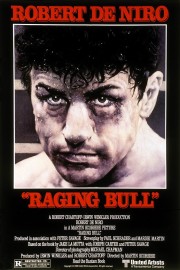Raging Bull
Martin Scorsese’s “Raging Bull” has the reputation of an “established masterpiece,” a film whose greatness is set in stone, having long survived the test of time. But watching it again for the first time in at least 15 years, one finds that it remains a riveting work of art, made by filmmakers who had something to prove, not just to the industry, but to themselves.
It’s been 18 years since Scorsese has collaborated with Robert DeNiro, who was the director’s on-screen muse starting with “Mean Streets,” and continuing with classics like “Taxi Driver,” “Raging Bull” (for which DeNiro won a much-deserved Oscar), and “GoodFellas,” to say nothing of “The King of Comedy” and a remake of “Cape Fear” almost as iconic as the original. Hopefully, these two will find a project to work together on again (Scorsese has been spending his time with Leonardo DiCaprio, another generational icon, of late), because when they get together, something special almost always occurs. That was certainly the case with “Raging Bull,” in which DeNiro played Jake LaMotta, a boxer from the ’40s and ’50s who was a champion in the ring, but a flawed, almost sociopathic individual when it comes to women. He may play a lady’s man when he first starts courting Vickie (Cathy Moriarity), but his inadequacies come to the surface soon enough. And for him, his time in the ring is how he pays for it.
The film begins in 1964, with an aging LaMotta getting ready for an evening devoted to him. He’s overweight and out-of-shape; hardly the physical specimen one would expect from someone who was a middleweight contender at the height of his popularity. It’s not long before we are in the ring with LaMotta during a 1941 bout with Jimmy Reese, which ends with his first loss. The fights that make him famous, though, are his battles with Sugar Ray Robinson– victories are won by both, but for LaMotta, it’s more about the punishment endured than winning, even though that’s the spin he puts on it for the world, including his brother, Joey (Joe Pesci). Interspersed between the scenes in the ring are scenes of LaMotta’s personal life, where we see a man who becomes a walking ball of anxiety and paranoia about whether his young wife, Vickie, is cheating on him. When Vickie confides in Joey, after he’s seen her out with some mob guys, that Jake attacks her sometimes, we learn a bit more about Jake’s issues with women, something we already kind of guessed after seeing him with his first wife.
This is a film I think every guy should see, and not just because it’s a great film, and one of Scorsese’s best. (I’d put it below “GoodFellas” and “The Last Temptation of Christ,” personally.) If you want to see the effects of anxiety and jealousy on a male, and the downward spiral it leads to, “Raging Bull”– written by Paul Schrader (who wrote “Taxi Driver”) and Mardik Martin (who wrote “Mean Streets”) –is a violent case study in the loneliness it results in. Scorsese and DeNiro don’t back away from the ugly details of LaMotta’s life, and with the boxer himself acting as a consultant, it doesn’t seem like he wanted them to. Subject, star, and director are in perfect harmony in telling this story, all wanting us to experience every minute so that we understand just how painful an existence LaMotta lived. He made amends for it in the ring, though; that’s what those fights became about. He seems much more level-headed after he retires, opening a nightclub, and still living with Vickie and his kids. In retirement, which came in 1956, he seems…happy, and content, and relatively well-adjusted (he’s still a flawed individual), having excised the last of his demons in his last, brutal battle with Sugar Ray Robinson, which features some of the film’s most iconic images. That ideal life doesn’t last long, though, and LaMotta is back to the same, rage-filled pile of id he was when he was boxing.
This is a film that seems, at times, too over-the-top to be true, but it’s that hyper real nature to the story that hits hardest when the film digs to it’s deepest emotional depths. That’s what makes each of his movies he’s done “based on a true story” so potent, whether it’s the raw nerves exposed in “Raging Bull”; the larger-than-life Hollywood lifestyle of Howard Hughes in “The Aviator”; and the perversion of the American Dream that is “GoodFellas.” This is where Scorsese excels, and rarely has he succeeded more than when he and Robert DeNiro turned an eye on a former champion, and didn’t flinch at the flaws boiling just underneath the surface.










